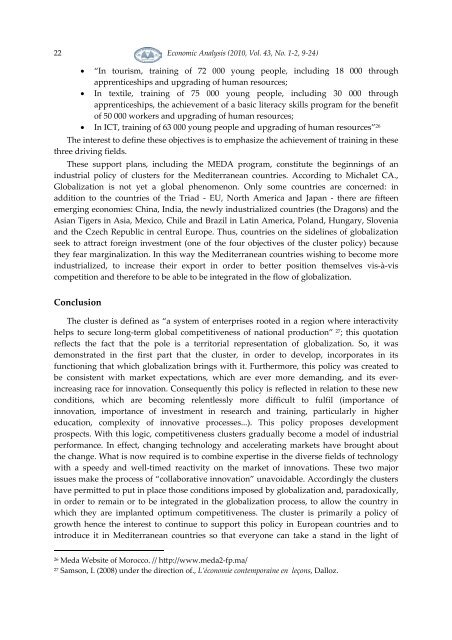Twice a Year Scientific Journal
Twice a Year Scientific Journal
Twice a Year Scientific Journal
Create successful ePaper yourself
Turn your PDF publications into a flip-book with our unique Google optimized e-Paper software.
22<br />
Economic Analysis (2010, Vol. 43, No. 1-2, 9-24)<br />
• “In tourism, training of 72 000 young people, including 18 000 through<br />
apprenticeships and upgrading of human resources;<br />
• In textile, training of 75 000 young people, including 30 000 through<br />
apprenticeships, the achievement of a basic literacy skills program for the benefit<br />
of 50 000 workers and upgrading of human resources;<br />
• In ICT, training of 63 000 young people and upgrading of human resources” 26<br />
The interest to define these objectives is to emphasize the achievement of training in these<br />
three driving fields.<br />
These support plans, including the MEDA program, constitute the beginnings of an<br />
industrial policy of clusters for the Mediterranean countries. According to Michalet CA.,<br />
Globalization is not yet a global phenomenon. Only some countries are concerned: in<br />
addition to the countries of the Triad - EU, North America and Japan - there are fifteen<br />
emerging economies: China, India, the newly industrialized countries (the Dragons) and the<br />
Asian Tigers in Asia, Mexico, Chile and Brazil in Latin America, Poland, Hungary, Slovenia<br />
and the Czech Republic in central Europe. Thus, countries on the sidelines of globalization<br />
seek to attract foreign investment (one of the four objectives of the cluster policy) because<br />
they fear marginalization. In this way the Mediterranean countries wishing to become more<br />
industrialized, to increase their export in order to better position themselves vis-à-vis<br />
competition and therefore to be able to be integrated in the flow of globalization.<br />
Conclusion<br />
The cluster is defined as “a system of enterprises rooted in a region where interactivity<br />
helps to secure long-term global competitiveness of national production” 27 ; this quotation<br />
reflects the fact that the pole is a territorial representation of globalization. So, it was<br />
demonstrated in the first part that the cluster, in order to develop, incorporates in its<br />
functioning that which globalization brings with it. Furthermore, this policy was created to<br />
be consistent with market expectations, which are ever more demanding, and its everincreasing<br />
race for innovation. Consequently this policy is reflected in relation to these new<br />
conditions, which are becoming relentlessly more difficult to fulfil (importance of<br />
innovation, importance of investment in research and training, particularly in higher<br />
education, complexity of innovative processes...). This policy proposes development<br />
prospects. With this logic, competitiveness clusters gradually become a model of industrial<br />
performance. In effect, changing technology and accelerating markets have brought about<br />
the change. What is now required is to combine expertise in the diverse fields of technology<br />
with a speedy and well-timed reactivity on the market of innovations. These two major<br />
issues make the process of “collaborative innovation” unavoidable. Accordingly the clusters<br />
have permitted to put in place those conditions imposed by globalization and, paradoxically,<br />
in order to remain or to be integrated in the globalization process, to allow the country in<br />
which they are implanted optimum competitiveness. The cluster is primarily a policy of<br />
growth hence the interest to continue to support this policy in European countries and to<br />
introduce it in Mediterranean countries so that everyone can take a stand in the light of<br />
26<br />
Meda Website of Morocco. // http://www.meda2-fp.ma/<br />
27<br />
Samson, I. (2008) under the direction of., L’économie contemporaine en leçons, Dalloz.
















